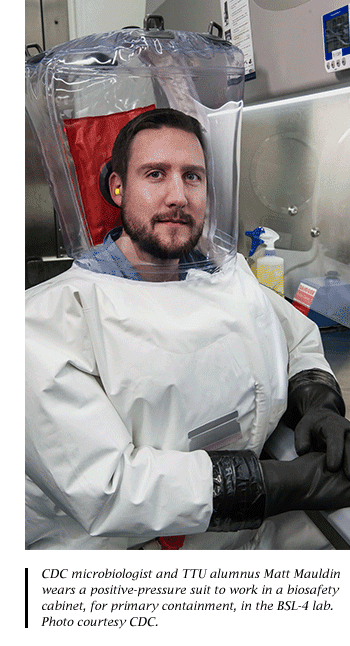Into the Petri Dish
Rabies Risk
3.3.2020 by Toni Salama
 Texas Tech University alumnus Matt Mauldin (BS Biology, 2008; PhD Biology, 2014) is a microbiologist in the Poxvirus and Rabies Branch at the
Atlanta-based Centers for Disease Control and Prevention (CDC), an arm of the U.S. Department of Health & Human Services.
Texas Tech University alumnus Matt Mauldin (BS Biology, 2008; PhD Biology, 2014) is a microbiologist in the Poxvirus and Rabies Branch at the
Atlanta-based Centers for Disease Control and Prevention (CDC), an arm of the U.S. Department of Health & Human Services.
Mauldin, who conducts research on rabies virus, says that rabies virus is not often perceived as a major human health concern in the United States because the canine rabies variant—the kind transmitted from dog to dog—has been eradicated in the United States.
Wildlife is another matter, though. In the United States, wild animals—primarily bats and carnivores—pose as reservoirs for other variants of the rabies virus, representing a real risk of transmission to humans, Mauldin says.
Worldwide, rabies virus kills approximately 60,000 people a year, mostly in Africa and Asia, he says.
Unfortunately, rabies can be transmitted to humans not only from direct contact with an infected animal but also from humans who have the virus and pass it on through transplanted organs.
A research paper published in The New England Journal of Medicine reported that in 2004, doctors at a hospital in Texas diagnosed rabies virus in three transplant patients who had received a liver and two kidneys from a common organ donor. Later, they discovered the rabies virus also had developed in a fourth transplant patient who received a vascular graft from the same donor during liver transplantation. All four recipients died within 50 days of transplantation.
Although rare, other cases of rabies virus transmitted via organ donation have been documented.
![]()
College of Arts & Sciences
-
Address
Texas Tech University, Box 41034, Lubbock, TX 79409-1034 -
Phone
806.742.3831 -
Email
arts-and-sciences@ttu.edu
